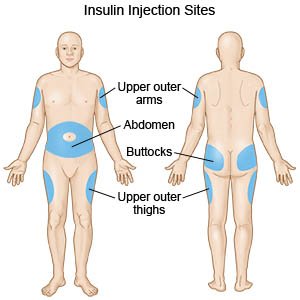Type 1 Diabetes: Don’t Sugar Coat It
October 12, 2015
Diabetes affects more than 29 million people in the United States. Depending on the type of diabetes, factors contributing to this disease are related to obesity, a sedentary lifestyle, and genetics. Insulin, a hormone, is used to transport glucose from the bloodstream into the cells of the body and therefore plays a large role in regulating blood glucose levels. Type 1 diabetes is usually diagnosed in younger patients and is when the body cannot produce enough insulin. In type 2 diabetes, the patient’s body cannot use the insulin it produces. Type 2 diabetes is more often diagnosed in adults, more specifically African American, Latino, Native American, and Pacific Islander individuals.
What factors can lead to T1D?
Diagnosis of type 1 diabetes can often result from a genetic predisposition and environmental factors. Often those with type 1 diabetes inherent risk factors from both parents, not just one. Type 1 diabetes develops more commonly in winter and is more prevalent in areas with colder temperature. Viruses also affect the onset of type 1 diabetes. A virus that may have a mild effect on one individual, may onset type 1 diabetes in another individual who is predisposed to the disease. Additionally early diets play a role in developing diabetes as T1D is less common in those who were breast fed than those who were not.
Blood Glucose Testing
How and when to test:
- Insert a test strip into the meter.
- Use the lancing device to get a drop of blood from the fingertip.
- Touch the test strip to the drop of blood and wait for the result.
- Your blood glucose level will appear on the meter.
Living with Type 1 Diabetes
Medication: Those with type 1 diabetes are unable to produce sufficient insulin from their pancreas. Therefore blood glucose levels must be monitored and controlled through daily injections of insulin through an insulin pen, syringe, or pump.

Exercise:
Exercise is a powerful tool to balance insulin doses. Responses to exercise on blood glucose levels before starting activity, intensity and duration of the activity, and recent changes in insulin doses. Often individuals with T1D experience a drop in blood glucose levels. If blood glucose levels drop to a certain level, hypoglycemia will occur. In this situation it is important to carry a carbohydrate food or drink that will quickly raise levels.
Blood glucose can also run high during or after high intensity exercises that increase stress hormones. If blood glucose levels are high before exercise, it is important to check for ketones in the blood or urine. If ketones are present, exercise should not occur.
Technological Advances
Insulin Pumps
Insulin pumps are small computerized devices that deliver insulin in steady measured and continuous doses, known as basal insulin, and as a surge dose around meal times. The pump injects insulin through a catheter, a small flexible plastic tube. The catheter is inserted through the skin into fatty tissue. While monitoring of blood glucose levels is still needed, insulin pumps allow those with T1D to better control their glucose levels. The delivery system mimics the pancreas’s normal insulin release responses.
Advantages:
- Replaces individual insulin injections.
- More accurate delivery of insulin.
- Results in fewer swings in blood glucose levels
Disadvantages:
- Can cause weight gain.
- Can cause diabetic ketoacidosis if catheter comes out on accident.
- Can be expensive.

Dexcom Continuous Glucose Monitoring
Dexcom offers a variety of blood glucose monitoring products such as the Dexcom G5, which allows dynamic glucose pattern monitoring. Dexcom created an implantable sensor that the body would not reject and that would perform for an extended period of time. The Dexcom reveals if glucose levels are trending up, down, or if it is at the appropriate level. The Dexcom CGM also has Bluetooth settings that allows the readings to be shared with loved ones across the country.
My Amazing Grace
On December 26, 2015 my little cousin Grace went into Ketoacidosis- her blood glucose levels were over 400 mg/dl. After being rushed to the hospital Grace was diagnosed with type 1 diabetes at age 8. Since her diagnosis, Grace has proved to be the strongest, most courageous little girl. She currently uses a Dexcom G4 to help monitor her blood glucose levels. She will be able to explore the insulin pump as an option this upcoming December. She looks at her diagnosis as just part of everyday life and does not let it slow her down. She has a passion to spread awareness about T1D.

Resources:
http://www.diabetes.org/
http://www.telegraph.co.uk/news/science/science-news/11151909/Cure-for-Type-1-diabetes-imminent-after-Harvard-stem-cell-breakthrough.html
References:
http://www.diffen.com/difference/Type_1_Diabetes_vs_Type_2_Diabetes
http://www.mayoclinic.org/diseases-conditions/diabetes/in-depth/blood-sugar/ART-20046628?
http://www.betterhealth.vic.gov.au/bhcv2/bhcarticles.nsf/pages/Diabetes_-_long-term_effects


Leave a Reply